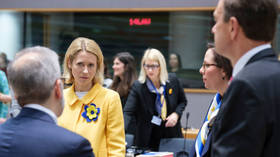Russia responds to seizure of valuable artworks

Finland will not be able to escape responsibility when it comes to the return of paintings and sculptures worth $46 million that belong to the Tretyakov Gallery, the Hermitage, and other museums in Russia, Moscow warned on Thursday. The statement came one day after Finnish Customs confirmed the seizure of the works, which were returning home from Italy and Japan.
The Russian Ministry of Foreign Affairs summoned Finnish Ambassador Antti Helantera and expressed “strong protest” over the actions.
“The Finnish side justified its actions citing sanctions imposed on Russia by the European Union. We stressed that what is happening cannot be called anything but legal chaos. The return of cultural property which was traveling abroad within the framework of cooperation between museum institutions cannot be subject to restrictions,” the ministry said in a statement.
It added that while Moscow expects a “prompt decision” from Finland regarding the return of Russia’s property, it is the responsibility of the authorities in Helsinki to keep the artwork safe.
“To escape from responsibility, hiding behind the position of the European Union, in this case will not be possible,” the Foreign Ministry warned.
Finnish Foreign Minister Pekka Haavisto, speaking to Yle TV channel on Thursday, underlined that the country’s customs service should strictly follow the EU’s regulations. However, his own position is that the objects of cultural heritage belong to the museums which originally lent them for the exhibitions. He explained that the sanctions against Russia are being imposed at such a pace that not all situations can be foreseen.
“I hope this can be resolved quickly. Finland has no reason to keep the objects of any museums here,” the minister said, adding that painting and sculptures should be treated with respect and kept in proper conditions.
“Of course, they should go back to the museums where they belong,” Haavisto said.
On Wednesday, Finnish Customs explained the seizure by saying that “a paragraph” of the EU sanctions against Russia – imposed over the course of the past six weeks due to the escalation of hostilities in Ukraine – referred to works of art. It also said that the unspecified number of paintings and sculptures was being stored “with overall consideration for their value, characteristics and safety.”
On April 4, the Kremlin’s special envoy for international cultural cooperation, Mikhail Shvidkoy, explained the “delay” in the return of the works by referring to sanctions-related “additional bureaucratic procedures,” and expressed certainty that they would return home upon completion of these procedures.
Following the launch of the Russian military offensive in Ukraine on February 24, Western countries imposed a wide spectrum of hard-hitting sanctions on Moscow. The restrictions, which Russia considers unlawful and unjustified, target various sectors of the Russian economy. At the moment, in Brussels, representatives of EU countries are discussing a fifth round of sanctions against Moscow.
Moscow attacked the neighboring state in late February, following Ukraine’s failure to implement the terms of the Minsk agreements signed in 2014, and Russia’s eventual recognition of the Donbass republics of Donetsk and Lugansk. The German and French brokered Minsk Protocol was designed to regularize the status of the regions within the Ukrainian state.
Russia has now demanded that Ukraine officially declare itself a neutral country that will never join the US-led NATO military bloc. Kiev insists the Russian offensive was completely unprovoked and has denied claims it was planning to retake the two regions by force.














